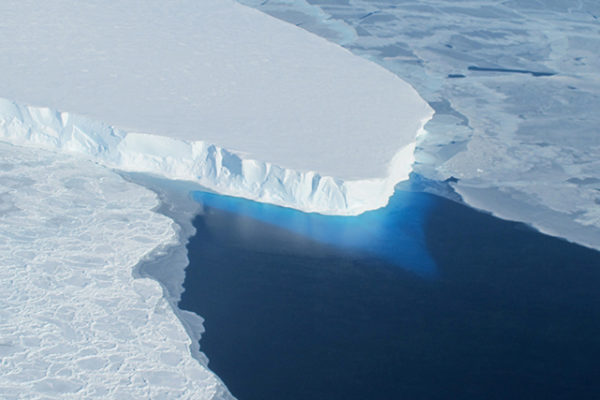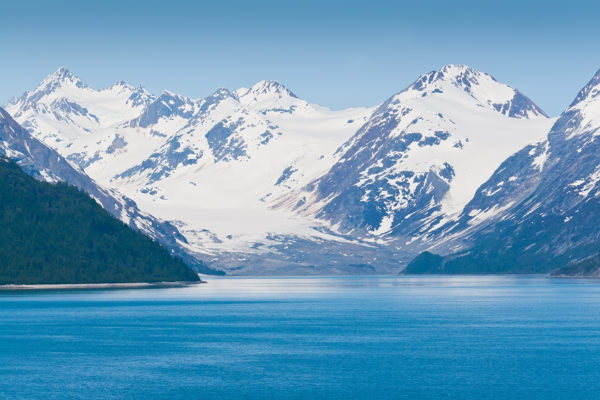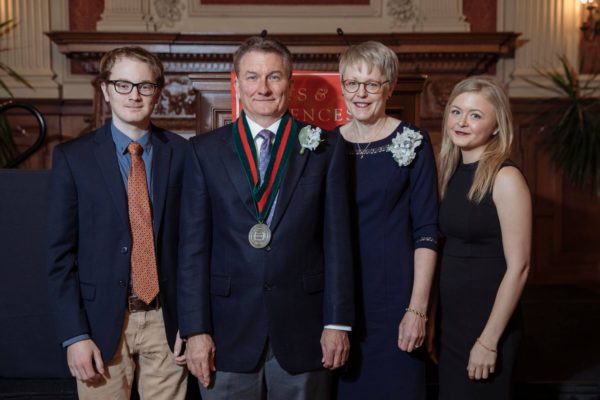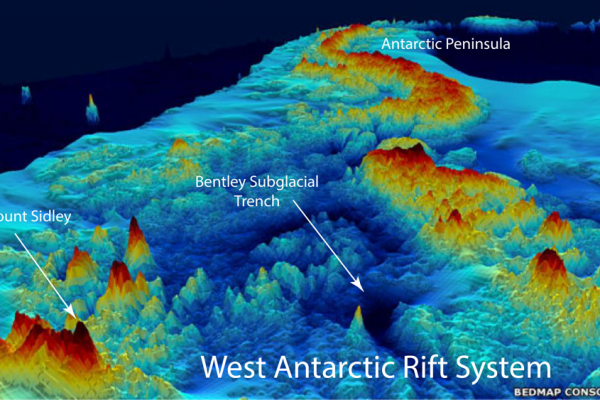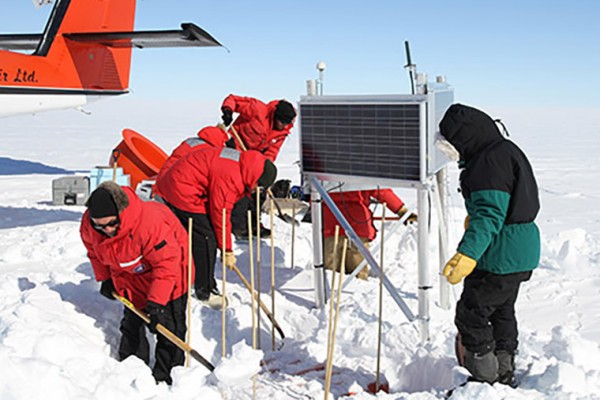Wiens specializes in seismology and geophysics and has done extensive research on large deep earthquakes in the Pacific Ocean. He also is researching the seismology of Antarctica. He has taught courses on earth forces, seismology, environmental geophysics and geodynamics. Through his research on the melting of ice sheets and the ensuing sea-level rise, Wiens is uniquely positioned to talk about climate change.

Douglas Wiens
Professor of Earth and Planetary Sciences, Robert S. Brookings Distinguished Professor
Contact Information
- Phone: 314-935-6517
- Email: doug@kermadec.wustl.edu
- Website: Website
Media Contact
In the media
Giant diamonds may hold the key to superdeep earthquakes
Doug Wiens, professor of earth and planetary sciences
The Search For Earth’s Underground Oceans
Douglas A. Wiens, Professor of Earth and Planetary Sciences, Robert S. Brookings Distinguished Professor
Oceans are being sucked into Earth’s interior through world’s deepest trenches
Doug Wiens, professor of earth and planetary sciences
How prepared is our area for an earthquake?
Doug Wiens, professor of earth and planetary sciences
U.S. marine seismologists fear loss of research ship
Doug Wiens, professor of earth and planetary sciences
Stories
Bedrock in West Antarctica rising at surprisingly rapid rate
The findings, reported in the journal Science, contain positive implications for the survival of the West Antarctic Ice Sheet, which scientists had previously thought could be doomed because of the effects of climate change, according to study co-author Douglas Wiens of Arts & Sciences.
Wiens, Shore to study seismic activity on Alaskan coast
Douglas Wiens, the Robert S. Brookings Distinguished Professor in Arts & Sciences at Washington University in St. Louis, and Patrick Shore, staff scientist and lecturer in earth and planetary sciences in Arts & Sciences, will collaborate with eight other institutions on a $4.5 million National Science Foundation study of a volatile volcano and earthquake zone on the sea floor off the Alaskan Peninsula.
Wiens installed as the Robert S. Brookings Distinguished Professor
Douglas Wiens was installed as the Robert S. Brookings Distinguished Professor in Arts & Sciences at a ceremony held Feb. 21 in Holmes Lounge at Washington University in St. Louis. He is the second faculty member to hold this professorship, which was established in 2006.
The geography of Antarctica’s underside
Scientists were able to deploy ruggidized seismometers that could withstand intense cold in Antarctica only recently. A line of seismometers strung across the West Antarctic Rift Valley and the Marie Byrd Land have given geologists their first good look at the mantle beneath the ice and rocks, revealing areas of hot rock that might affect the behavior of the overlying ice sheet.
2010 Chilean earthquake triggered icequakes in Antarctica
In March 2010, the ice sheets in Antarctica vibrated a bit more than usual as a surface wave from an 8.8-magnitude earthquake in Chile 3,000 kilometers away passed through the ice. Powerful earthquakes were known to trigger secondary quakes along faults in land; this was the first observation of triggered quakes in the ice. Washington University in St. Louis seismologist Doug Wiens says the finding is one of several discoveries made possible by POLENET, an array of seismic stations that reaches for the first time into the interior of Antarctica.
Seismic survey at the Mariana trench will follow water dragged down into the Earth’s mantle
Seismologists have just returned from a cruise in the Western Pacific to lay the instruments for a seismic survey that will follow the water chemically bound to or trapped in the down-diving Pacific Plate at the Mariana trench, the deep trench to which Avatar director James Cameron is poised to plunge.
Two Washington University in St. Louis geologists comment on the Japanese earthquake
In the weeks following the earthquake, two geologists at Washington University in St. Louis — Doug Wiens, PhD, professor and chair of earth and planetary sciences in Arts & Sciences, and Michael Wysession, PhD, associate professor of earth and planetary sciences — were frequently interviewed by journalists seeking to understand a catastrophe that seemed at times beyond understanding. What did the two scientists think about the quake? What was expected and what surprised them?
Storms, soccer matches hidden in seismometer noise
Who knew? The chance discovery that spikes in seismometer noise recorded in Africa corresponded with soccer matches has led to the discovery that there’s a lot more buried in the noise, including a signal from the famous storms of the Southern Atlantic Ocean, the bane of ships of sail.
Seismologist in the field
Most of us return from a business trip with receipts for coffee and perhaps a glass or two of wine. Doug Wiens, PhD, professor and chair of the Department of Earth and Planetary Sciences in Arts & Sciences, once came back with receipts for several hundred dollars of kava root.
U.S.-led team confirms an Alps-like mountain range exists under east Antarctic ice sheet
Flying twin-engine light aircraft the equivalent of three trips around the globe and working in temperatures that averaged minus 30 degrees Celsius, an international team of scientists, including one from Washington University in St. Louis, has not only verified the existence of a mountain range that is suspected to have caused the massive East Antarctic Ice Sheet to form, but also has created a detailed picture of the rugged landscape buried under more than four kilometers (2.5 miles) of ice. Douglas A. Wiens, Ph.D., WUSTL professor and chair of earth and planetary sciences, is part of the seismology team.
Wiens heads seismology effort in Antarctica
Douglas A. Wiens, Ph.D., professor and chair of earth and planetary sciences in Arts & Sciences, will head the seismology research team of an ambitious international effort to map and analyze an unknown part of Antarctica.
Wiens heads seismology effort in international Antarctic study
Douglas A. Wiens, Ph.D., professor and chair of earth and planetary sciences in Arts & Sciences, will head the seismology research team of an ambitious international effort to map and analyze an unknown part of Antarctica. The project is called AGAP (Antarctica’s Gamburtsev Province) after the Gamburtsev Subglacial Mountains, which are the main feature of the region. Wiens, Patrick Shore, computer specialist in earth and planetary sciences, and graduate students David Heizel and Amanda Lough will install 26 seismographs on the frozen surface of central Antarctica, a part of the world that is a geological mystery.
Data show Antarctic ice stream radiating seismically
Image courtesy of Doug WiensDouglas Wiens (left), and a colleague ready equipment to emplace seismographs in Antarctica during a 2001 expedition.A seismologist at Washington University in St. Louis along with colleagues at Pennsylvania State University and Newcastle University in the United Kingdom have found seismic signals from a giant river of ice in Antarctica that make California’s earthquake problem seem trivial. Douglas A. Wiens, Ph.D., professor of earth and planetary sciences in Arts & Sciences, and colleagues combined seismological and global positioning system (GPS) analyses to reveal two bursts of seismic waves from an ice stream in Antarctica every day, each one equivalent to a magnitude seven earthquake.
Earthquake in Illinois could portend an emerging threat
Two seismologists at Washington University in St. Louis think the New Madrid Fault may have seen its day and the Wabash Fault is the new kid on the block. “I think everyone’s interested in the Wabash Valley Fault because a lot of the attention has been on the New Madrid Fault, but the Wabash Valley Fault could be the more dangerous one, at least for St. Louis and Illinois,” said Doug Wiens, professor of earth and planetary sciences in Arts & Sciences. “The strongest earthquakes in the last few years have come from the Wabash Valley Fault, which needs more investigation.”
Tonga quake not conducive to tsunami
The figure shows the dynamics of a slab-tear earthquake (top), compared with a shallow thrust earthquake (bottom). The slab-tearing event typically doesn’t feature an accompanying tsunami.Seismologists at Washington University in St. Louis and their colleagues in Australia, Japan and Tonga have determined why a large earthquake in Tonga did not cause a large tsunami. A tsunami warning was issued around the Pacific Rim following the magnitude 8.0 earthquake on May 3, 2006, but the resulting tsunami was very minor and caused no damage.
WUSTL seismologist: Tsunami warning system needed in Indian Ocean
Calm seas can turn deadly when tsunamis strike.Tens of thousands of people who perished in the Indonesia tsunami would be alive today had there been a warning system in place in the Indian Ocean basin similar to one in place for 40 years in the Pacific Ocean, says a seismologist at Washington University in St. Louis. Douglas A. Wiens, Ph.D., professor of earth and planetary sciences in Art & Sciences, says it’s unfortunate, but the catastrophic tragedy will be the catalyst for developing such a system, just as the 1964 Alaska tsunami event triggered the installment of the current Pacific Ocean system.”
Seismologists record unexpected volcanic eruption on Pacific isle
Photo by Patrick ShoreAnatahan eruption yields spectacular images, seismic data trove.Washington University geophysicists were fortunate to observe the May 10 eruption of a long dormant volcano on the uninhabited island Anatahan, part of the U.S.-administered Commonwealth of the Northern Marianas in the western Pacific. A seismograph they deployed there only a few days before the unexpected eruption has captured a trove of important seismic data — a detailed chronology of pre- and post-eruption rumblings. While the team’s primary focus is exploring the tectonic forces in the region, the chance capture of detailed volcanic eruption data may offer new avenues of research, perhaps providing tools to help access volcanic and seismic hazards to the people of the Marianas.
